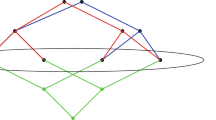Abstract
We give an exponential lower bound for the smallest \(N\) such that no matter how we c-color the edges of a complete \(r\)-uniform hypergraph on \(N\) vertices, we can always find a monochromatic Berge-\(K_n\).
Similar content being viewed by others
Gerbner and Palmer [5], generalizing the definition of hypergraph cycles due to Berge, introduced the following notion. A hypergraph H contains a Berge copy of a graph G, if there are injections \(\Psi _1: V(G)\rightarrow V(H)\) and \(\Psi _2: E(G) \rightarrow E(H)\) such that for every edge \(uv\in E(G)\) the containment \(\Psi _1(u),\Psi _1(v)\in \Psi _2(uv)\) holds, i.e., each graph edge can be mapped into a distinct hyperedge containing it to create a copy of G. If \(|E(H)|=|E(G)|\), then we say that H is a Berge-G, and we denote such hypergraphs by \({\mathcal {B}}G\).
The study of Ramsey problems for such hypergraphs started independently in 2018 by three groups of authors [1, 4, 6]. Denote by \(R_r({\mathcal {B}}G; c)\) the size of the smallest N such that no matter how we c-color the r-edges of \(K_N^r\), the complete r-uniform hypergraph, we can always find a monochromatic \({\mathcal {B}}G\). In [1] \(R_r({\mathcal {B}}K_n; c)\) was studied for \(n=3,4\). In [4] it was conjectured that \(R_r({\mathcal {B}}K_n; c)\) is bounded by a polynomial of n (depending on r and c), and they showed that \(R_r({\mathcal {B}}K_n; c)=n\) if \(r>2c\) and \(R_r({\mathcal {B}}K_n; c)=n+1\) if \(r=2c\), while \(R_3({\mathcal {B}}K_n; 2)< 2n\) (also proved in [6]). In [6] a superlinear lower bound was shown for \(r=c=3\) and for every other r for large enough c. This was improved in [3] to \(R_{r}({\mathcal {B}}K_n; c)=\Omega (n^{d})\) if \(c>(d-1)\left({{r}\atop {2}}\right)\) and \(R_r({\mathcal {B}}K_n; c)=\Omega (n^{1+1/(r-2)}/\log n)\). We further improve these to disprove the conjecture of [4].
\(R_{r}\left( {\mathcal {B}}K_n; c\right) > \left( 1+\frac{1}{r^2}\right) ^{n-1}\) if \(c>\left({{r}\atop {2}}\right)\).
FormalPara ProofIt is enough to prove the statement for \(c=\left({{r}\atop {2}}\right) +1\). For \(r=2\) this reduces to the classical Ramsey’s theorem, so we can assume \(r\ge 3\). We can also suppose \(n\ge \left({{r}\atop {2}}\right) +1=c\), or the lower bound becomes trivial. Suppose \(N\le (1+\frac{1}{r^2})^{n-1}\). Assign randomly (uniformly and independently) a forbidden color to every pair of vertices in \(K_N^r\). Color the r-edges of \(K_N^r\) arbitrarily, respecting the following rule: if \(\{u,v\}\subset E\), then the color of E cannot be the forbidden color of \(\{u,v\}\). Since \(c>\left({{r}\atop {2}}\right)\), this leaves at least one choice for each edge. Following the classic proof of the lower bound of the Ramsey’s theorem, now we calculate the probability of having a monochromatic \({\mathcal {B}}K_n\). The chance of a monochromatic \({\mathcal {B}}K_n\) on a fixed set of n vertices for a fixed color is at most \((\frac{c-1}{c})^{\left( {{n}\atop{2}}\right)}\), as the fixed color cannot be the forbidden one on any of the pairs of vertices. Thus the expected number of monochromatic \({\mathcal {B}}K_n\)’s is at most \(c\left( {{N}\atop {n}}\right) (\frac{c-1}{c})^{\left( {{n}\atop{2}}\right)}\). If this quantity is less than 1, then we know that a suitable coloring exists. Since \(c\le n\le n!\), it is enough to show that \(N< (\frac{c}{c-1})^{\frac{n-1}{2}}\), but this is true using \(c=\left({{r}\atop {2}}\right) +1\) and \(r\ge 3\). \(\square\)
1 Remarks and Acknowledgment
As was brought to my attention by an anonymous referee, my construction for \(r=3\) and \(c=4\) is essentially the same as the one used in the proof of Theorem 1(ii) in [2] for a different problem, the 4-color Ramsey number of the so-called hedgehog. A hedgehog with body of order n is a 3-uniform hypergraph on \(n+\left( {{n}\atop{2}}\right)\) vertices such that n vertices form its body, and any pair of vertices from its body are contained in exactly one hyperedge, whose third vertex is one of the other \(\left( {{n}\atop{2}}\right)\) vertices, a different one for each hypderedge. It is easy to see that such a hypergraph is a Berge copy of \(K_n\), and while their result, an exponential lower bound for the 4-color Ramsey number of the hedgehog, does not directly imply mine, their construction is such that it also avoids a monochromatic \({\mathcal {B}}K_n\).
It is an interesting problem to determine how \(R_{r}({\mathcal {B}}K_n; c)\) behaves if \(c\le \left({{r}\atop {2}}\right)\). The first open case is \(r=c=3\), just like for hedgehogs.
References
Axenovich, M., Gyárfás, A.: A note on Ramsey numbers for Berge-G hypergraphs. Discrete Math. 342(5), 1245–1252 (2019)
Conlon, D., Fox, J., Rödl, V.: Hedgehogs are not colour blind. J. Combin. 8(3), 475–485 (2017)
Gerbner, D.: On Berge-Ramsey problems. Electro. J. Combin. 27(2), P2.39 (2020)
Gerbner, D., Methuku, A., Omidi, G., Vizer, M.: Ramsey problems for Berge hypergraphs. SIAM J. Discrete Math. 34(1), 351–369 (2020)
Gerbner, D., Palmer, C.: Extremal Results for Berge Hypergraphs. SIAM J. Discrete Math. 31(4), 2314–2327 (2017)
Salia, N., Tompkins, C., Wang, Z., Zamora, O.: Ramsey numbers of Berge-hypergraphs. Electro. J. Combin. 26(4), P4.40 (2019)
Funding
Open access funding provided by Eötvös Loránd University.
Author information
Authors and Affiliations
Corresponding author
Additional information
Publisher's Note
Springer Nature remains neutral with regard to jurisdictional claims in published maps and institutional affiliations.
Rights and permissions
Open Access This article is licensed under a Creative Commons Attribution 4.0 International License, which permits use, sharing, adaptation, distribution and reproduction in any medium or format, as long as you give appropriate credit to the original author(s) and the source, provide a link to the Creative Commons licence, and indicate if changes were made. The images or other third party material in this article are included in the article's Creative Commons licence, unless indicated otherwise in a credit line to the material. If material is not included in the article's Creative Commons licence and your intended use is not permitted by statutory regulation or exceeds the permitted use, you will need to obtain permission directly from the copyright holder. To view a copy of this licence, visit http://creativecommons.org/licenses/by/4.0/.
About this article
Cite this article
Pálvölgyi, D. Exponential Lower Bound for Berge-Ramsey Problems. Graphs and Combinatorics 37, 1433–1435 (2021). https://doi.org/10.1007/s00373-021-02328-3
Received:
Accepted:
Published:
Issue Date:
DOI: https://doi.org/10.1007/s00373-021-02328-3




